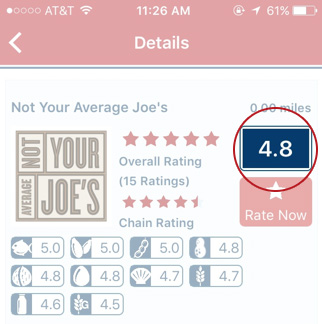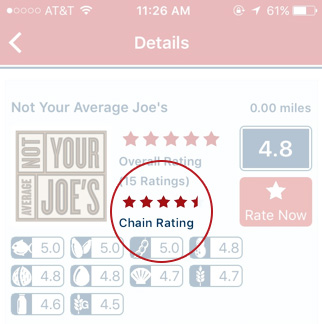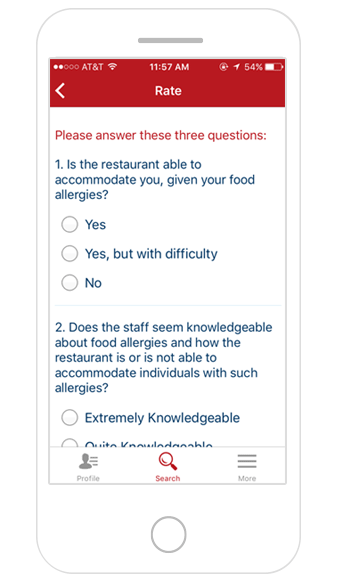How AllergyEats Works
Trusted by food-allergic diners since 2010, AllergyEats is the leading guide to allergy-friendly restaurants across the United States. Whether near your home or while traveling, you can use the AllergyEats app or site to help you learn more about the “food allergy-friendliness” of area restaurants by entering your desired location and selecting any or all of your allergies (Top 8, Sesame and Gluten). AllergyEats generates results relevant to your search, giving you a list of restaurants to consider (or avoid), based solely on the input provided by other food-allergic diners and not the restaurateurs themselves. Rated restaurants not only include a numeric “Overall” rating but most also have comments from those who rated the restaurant (citing all of their allergies, from a less common garlic allergy to a more common peanut allergy and everything in-between). In addition, many restaurant listings feature ratings specific to individual allergies as well as chain-level ratings.

What do the ratings mean?
The AllergyEats “Overall” Allergy Rating is denoted on a 1-5 scale as a measure of how well that specific restaurant has accommodated patrons with food allergies or intolerances, regardless of the specific allergy or intolerance, based on the reviews from actual food-allergic diners. This rating is not derived from food allergy or dining experts, but from the actual experiences of the entire community of food-allergic and food-intolerant diners. This rating is also not specific to what is or isn’t on the menu, whether specific allergens are present onsite, or anything related to the general taste and quality of the food. This rating reflects the “wisdom of the crowd” and is intended to reflect the real world experiences of the food allergy community.
How can a restaurant be allergy-friendly if they serve the offending allergen?
“I never refer to a restaurant, or frankly any place, as “allergy-safe” because there simply can be no guarantees,” said AllergyEats founder and CEO Paul Antico. “When I refer to a restaurant being ‘allergy-friendly,’ on the other hand, I’m implying an establishment where the odds of a food-allergic diner having a safe experience is higher than at non-allergy friendly restaurants.”
Most restaurant that serve individuals with food allergies and intolerances do have an individual’s allergens on-site. However, truly competent allergy-friendly restaurants have been trained on procedures and protocols to accommodate food-allergic diners and will help individuals select the right dish that doesn’t contain their allergens, offer suitable alternatives or alterations to a dish, and ensure that cross-contact with the individual’s allergen doesn’t happen in the kitchen or elsewhere. However, there are never guarantees and no “allergy-safe” restaurants. Always bring your life-saving (and other) medication.

What is the “Chain” rating?
The chain rating, where listed, is the same as the Overall rating except that it is a measure of ALL the U.S. units of the chain to which that restaurant belongs, as opposed to the rating of just that individual unit.

What are the allergy-specific ratings and why are they different from the Overall rating?
Allergy-specific ratings, where listed, are calculated similarly to the “Overall” rating, except that the results are based only on the feedback of users with that specific allergy or intolerance. These ratings are only displayed for the specific allergies which the user has indicated in the search and only if individuals with those specific allergies have already rated the restaurant. Once again, this is a measure of how well the restaurant was able to accommodate these patrons, regardless of whether or not the specific allergens are present onsite.
A restaurant came up as highly rated overall, but did not include ratings from individuals with the same allergies as mine. Is the rating still valid?
In our experience, we have found that most restaurants that can properly accommodate individuals with one specific allergy have the knowledge and training to accommodate people with others as well. However, this is not universally true, particularly if a restaurant’s “theme” involves a heavy focus on a specific food or ingredient that some may be allergic to. That said, the more positive reviews there are, the more strongly we would suggest considering that restaurant as a possibility and calling them for more information.

How are the ratings determined?
Ratings are based solely on the answers diners have given to 3 questions about how the restaurant accommodated their food allergy restrictions. Using a proprietary method that weights responses to the 3 questions and considers every rater’s indicated allergies, a numerical rating number is determined for each allergen and for the restaurant overall. While individuals can rate a restaurant multiple times, only their most recent rating will count in the calculation of the overall restaurant rating (their comments of each individual experience will remain, however).
Ready to Find, Rate, and Share on AllergyEats now? Or more questions?
We are always receptive to questions and feedback, so please let us know if you have further questions. We hope that this has encouraged you not only to FIND restaurants using AllergyEats, but also to also RATE and SHARE your own dining experiences for the benefit of others. Every time someone adds a single new rating, AllergyEats becomes more valuable for the entire food allergy community.

